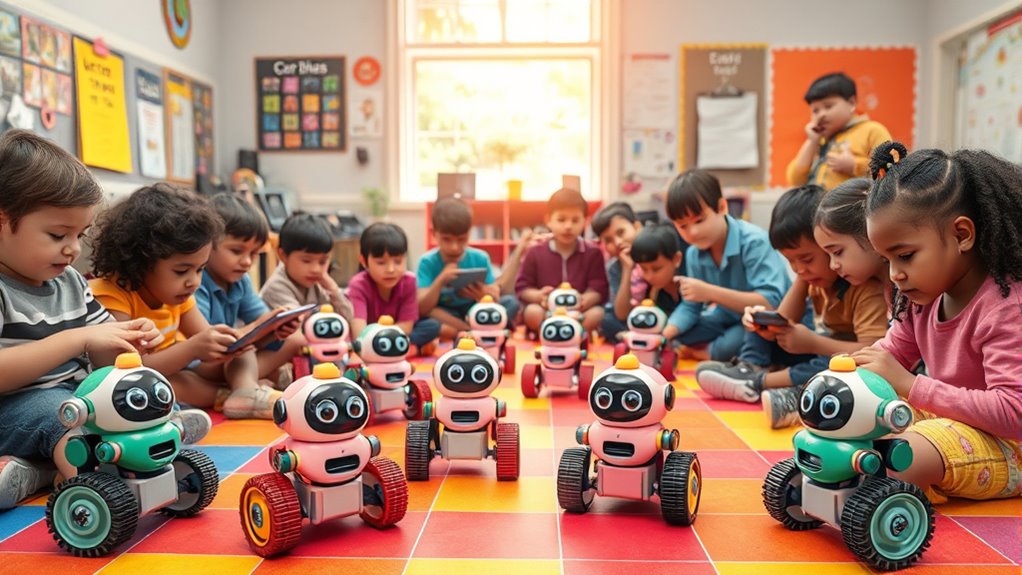If you’re looking for fun and easy-to-use coding robots for kids, I recommend checking out options like Sphero Mini, Botley, Makeblock mBot, and Dash. These robots are designed to engage children with hands-on activities, colorful lights, and simple programming interfaces like drag-and-drop or Scratch. They suit various ages, boost STEM skills, and promote creative problem-solving. Keep exploring, and you’ll discover even more great choices to inspire your child’s coding journey.
Key Takeaways
- These robots offer engaging, hands-on learning with visual programming, making coding accessible and fun for kids of various ages.
- Many models include features like obstacle avoidance, drawing, and remote control, enhancing interactive learning experiences.
- Compatibility with beginner-friendly coding languages like Scratch, Blockly, or JavaScript simplifies programming for young learners.
- Most kits are designed for easy assembly and setup, promoting independence and confidence in learning to code.
- They support STEM development through creative tasks, problem-solving, and adaptable challenges suitable for different skill levels.
Sphero Mini Blue Coding Robot Ball for Kids and Teens
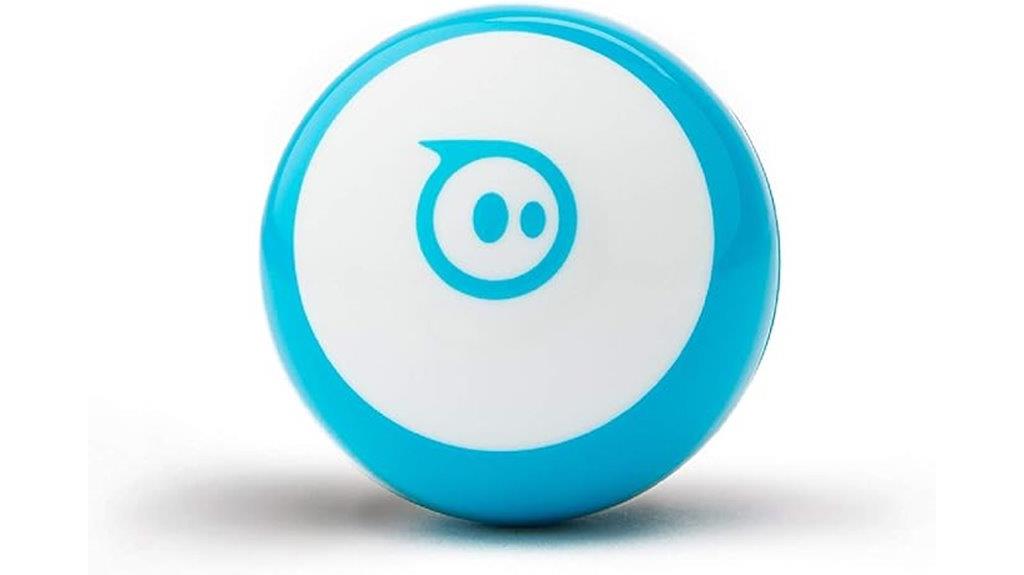
The Sphero Mini Blue is an ideal choice for kids and teens who want a compact, durable robot that makes learning to code fun and engaging. About the size of a ping pong ball, it’s equipped with sensors like a gyroscope, accelerometer, and colorful LED lights, creating an interactive experience. The robot connects via Bluetooth and supports coding through the free Sphero Edu app, offering options like drawing, drag-and-drop blocks, or JavaScript. Its versatility includes obstacle courses, gaming, and STEM projects. Built to handle jumps and collisions, it performs well on hardwood floors and thin carpets, making it perfect for energetic learners.
Best For: kids, teens, and educators seeking a compact, durable, and versatile coding robot that combines fun with STEM learning.
Pros:
- Compact size and colorful LED lights enhance engagement and portability.
- Supports multiple coding methods including drawing, drag-and-drop blocks, and JavaScript.
- Durable design handles jumps and collisions, suitable for active play on hardwood and thin carpets.
Cons:
- Can disconnect from Bluetooth unexpectedly and may require manual realignment.
- Control responsiveness can sometimes be inconsistent, especially on thick carpets.
- Out-of-the-box joystick controls may feel finicky or difficult to master.
Learning Resources Botley the Coding Robot, Coding STEM Toy
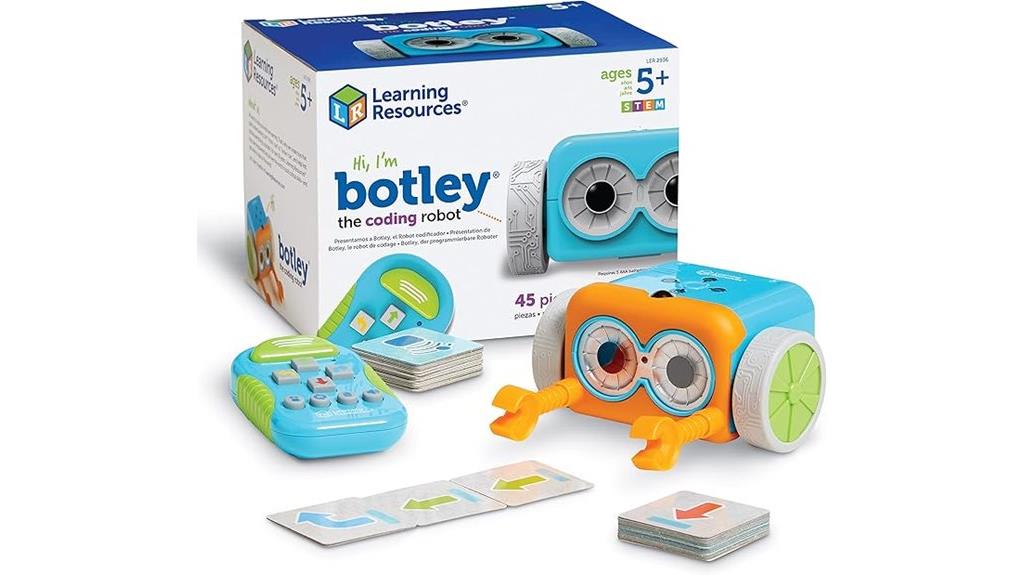
If you’re looking for a coding robot that introduces young children to STEM concepts without screens, Botley the Coding Robot is an excellent choice. It’s designed for kids aged 5 and up, offering a screen-free coding experience with a 45-piece activity set, including a remote programmer, coding cards, and obstacle components. Botley features obstacle avoidance, line-following, looping commands, and secret tricks, encouraging creativity and problem-solving. It’s easy to set up and use, with engaging sounds and visual cues. Although some features can be finicky and battery life is high, kids love exploring coding, maze building, and interactive challenges with Botley.
Best For: children aged 5 and above who are interested in learning basic coding and STEM concepts without the use of screens.
Pros:
- Encourages early STEM skills and problem-solving through fun, interactive play.
- Easy to set up and operate, with engaging sounds and visual cues that aid learning.
- Promotes creativity with maze building, obstacle courses, and secret tricks to explore.
Cons:
- Some features like obstacle detection and black-line following can be finicky, especially on carpets.
- Limited maze size and number of coding cards restrict extended gameplay and maze complexity.
- High battery consumption, often requiring many AAA batteries, which can be costly and inconvenient.
Makeblock mBot Robot Kit for Kids Ages 8-12 STEM Coding and Robotics Science Kit
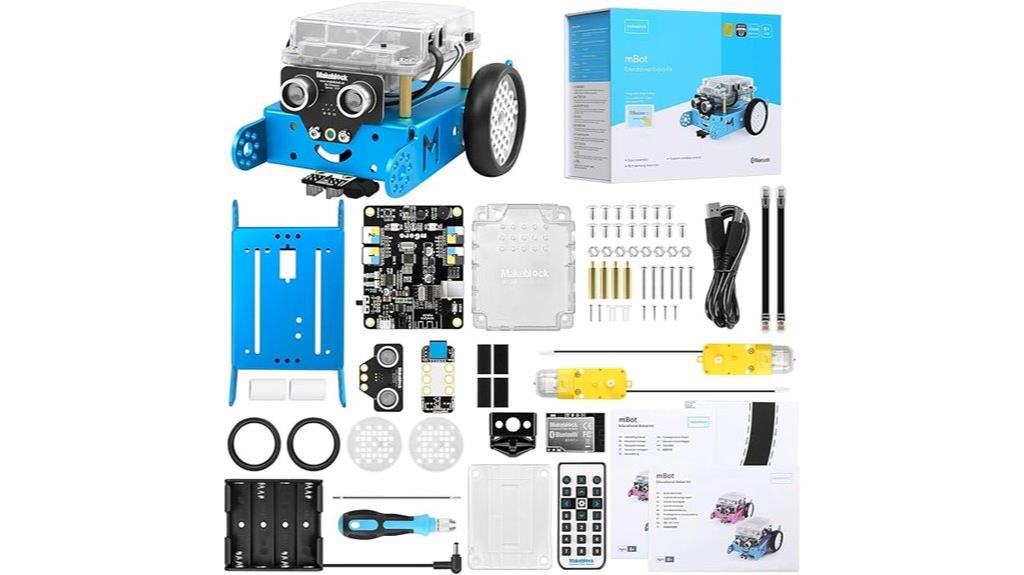
Designed specifically for children aged 8 to 12, the Makeblock mBot Robot Kit makes learning robotics and coding both accessible and engaging. It’s easy to assemble in just 15 minutes, featuring clear instructions, and functions as a remote control car with line-following and obstacle avoidance. The open-source system connects with over 100 electronic modules and 500 parts, compatible with LEGO. Kids can learn electronics, robotics, and programming through interactive tutorials, coding cards, and free apps using Scratch and Arduino. Rated 4.6 stars, this kit combines fun, education, and creativity, making it a perfect gift for young aspiring engineers.
Best For: young children aged 8 to 12 who are interested in learning robotics, electronics, and coding in a fun and accessible way.
Pros:
- Easy to assemble within 15 minutes with clear instructions.
- Offers engaging educational content with tutorials, coding cards, and compatible apps.
- Open-source system with extensive expandability, connecting to over 100 electronic modules and 500 parts.
Cons:
- Some users report that downloading the programming tools can be confusing or unclear.
- The learning curve may be steep for absolute beginners without prior tech experience.
- Limited functionality out-of-the-box; expanding features requires additional parts and modules.
Mech 5, Mechanical Coding Robot
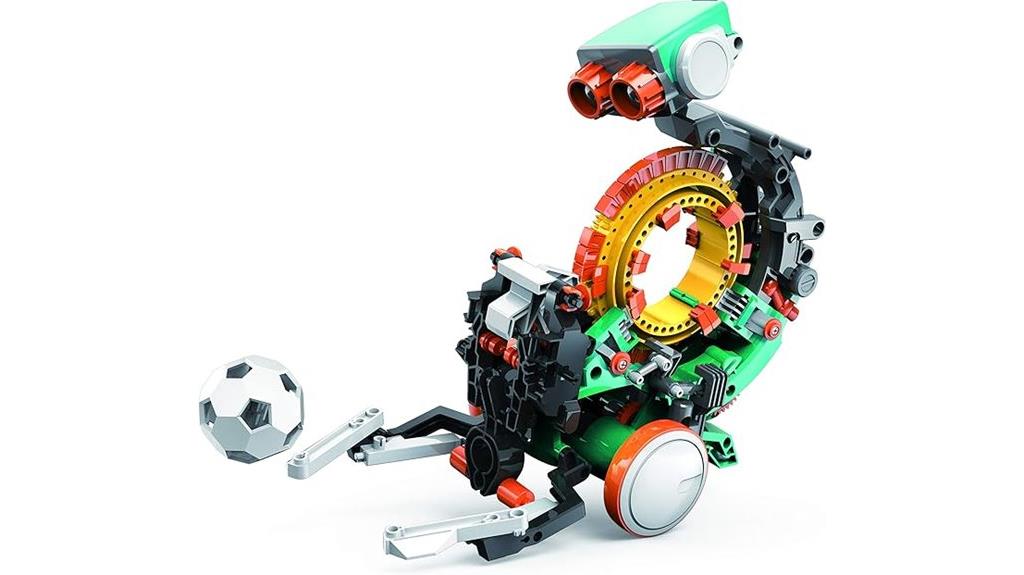
Mech 5 stands out as an excellent choice for kids aged 10 and up who are enthusiastic to learn mechanical engineering and coding through hands-on building. This mission-based STEM robot encourages creativity by allowing kids to assemble and program actions like throwing, lifting, and drawing using snap-on coding buttons. Powered by renewable energy sources—water, wind, or sun—it’s eco-friendly and battery-free. While assembly can be challenging and may require adult help, the process promotes patience and mechanical skills. Once built, kids can enjoy controlling a fragile but fun robot that sparks problem-solving and engineering interest, making learning both engaging and rewarding.
Best For: kids aged 10 and up who are eager to learn mechanical engineering and coding through hands-on building and programming activities.
Pros:
- Encourages creativity, problem-solving, and mechanical skills through active assembly and programming
- Eco-friendly design powered by water, wind, or sun, eliminating the need for batteries
- Engages children with fun, mission-based tasks like throwing, lifting, and drawing
Cons:
- Assembly can be time-consuming and challenging, often requiring adult assistance
- Plastic gears and parts may be fragile and prone to breaking with use or mishandling
- The robot can be loud during operation and may have a learning curve for programming beginners
Dash Robot, Voice-Activated STEM Robot Toy for Kids 6

The Dash Robot stands out as an excellent choice for kids aged 6 and up who are just starting to explore coding and robotics. It’s ready to use right out of the box, requiring no assembly, with a sleek, durable design and smooth motors that handle obstacle navigation and different terrains. With up to 5 hours of battery life and quick USB charging, it’s perfect for extended play. The robot works with multiple apps, from simple remote control to advanced programming, teaching concepts like sequencing and loops. Its engaging appearance and responsive controls make learning fun, fostering creativity and problem-solving skills in young learners.
Best For: kids aged 6 and up who are beginning to explore coding, robotics, and STEM learning through an engaging, ready-to-use toy.
Pros:
- No assembly required; ready to use right out of the box, ideal for young children and beginners.
- Versatile programming options through multiple apps, from simple remote control to complex coding challenges.
- Durable, sleek design with smooth motors capable of obstacle navigation and traversing various terrains.
Cons:
- Lacks a camera, limiting certain interactive features.
- Some users wish for enhanced code export/view capabilities for more advanced programming.
- Occasional issues like battery discharge or vibration problems, though generally addressed by customer support.
ELEGOO UNO R3 Robot Car Kit for Arduino STEM Science Kits for Kids and Teens
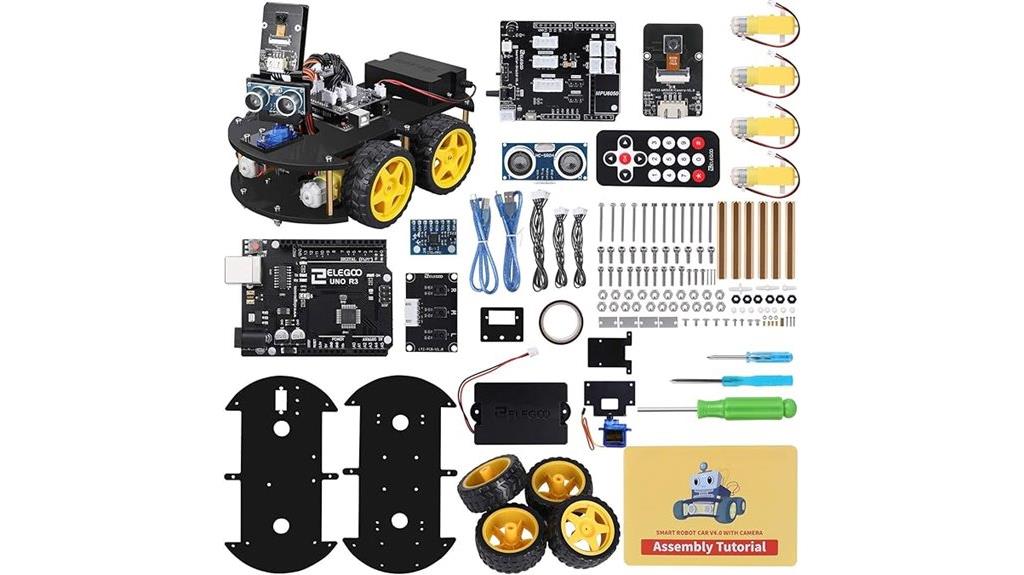
If you’re looking for an educational robot kit that combines ease of use with versatile learning features, the ELEGOO UNO R3 Robot Car Kit is a great choice for kids and teens aged 8-16. It offers hands-on experience in programming, electronics, and robotics, including 24 modules like obstacle avoidance and line tracing. Assembly is straightforward with clear instructions, though small parts may challenge beginners. The kit includes motors, sensors, and a camera, with pre-loaded code to get started quickly. Users love its durability and fun factor, though some find the programming and assembly a bit complex. Overall, it’s a solid introduction to STEM robotics.
Best For: kids and teens aged 8-16 seeking a hands-on, educational introduction to programming, electronics, and robotics through a versatile and durable STEM kit.
Pros:
- Includes 24 modules such as obstacle avoidance and line tracing for diverse learning experiences
- Easy assembly process with clear instructions suitable for users with some experience
- Supports control via Android and iOS devices, enhancing remote operation and experimentation
Cons:
- Small parts and alignment issues may challenge beginners during assembly
- Programming and setup can be complex for users with limited prior experience
- WiFi connection sensitivity and limited remote control range may affect user convenience
Learning Resources Code & Go Robot Mouse Activity Set
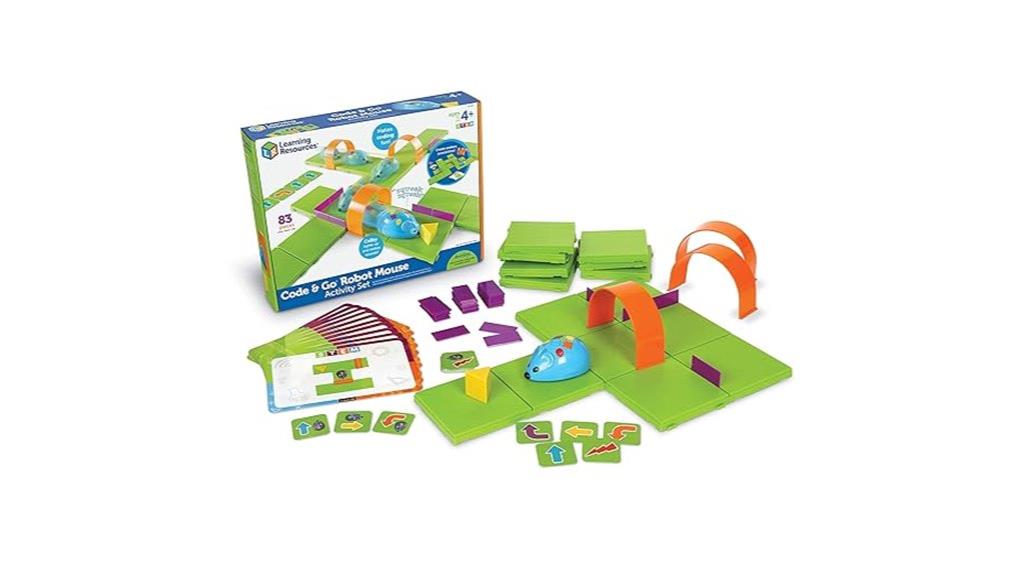
For parents and educators seeking an engaging, screen-free way to introduce young children to coding, the Learning Resources Code & Go Robot Mouse Activity Set stands out as an excellent choice. This durable set includes a programmable robot mouse, maze grids, walls, tunnels, coding cards, and activity challenges, all designed for kids ages 4 and up. Kids develop critical skills like problem-solving, sequencing, and spatial reasoning while designing mazes and programming the mouse using color-coded buttons. The set’s scalable design allows for simple to complex challenges, fostering creativity and logical thinking. Easy to assemble and operate, it offers a fun, hands-on introduction to foundational coding concepts.
Best For: young children aged 4 and up, parents, and educators looking for a screen-free, engaging, and educational introduction to coding and STEM skills.
Pros:
- Encourages critical thinking, problem-solving, and sequencing skills through hands-on play
- Scalable design with simple and complex challenges suitable for various ages and skill levels
- Durable, easy-to-assemble components and clear instructions promote independent use and learning
Cons:
- The robot mouse may occasionally not execute turns precisely or stop after reaching the cheese, limiting some programming scenarios
- Requires 3 AAA batteries (not included), which adds an extra step for setup
- Younger children under age 4 might enjoy watching the mouse move but may not fully grasp the programming concepts
Evo Entry Kit Interactive Coding Robot for Kids
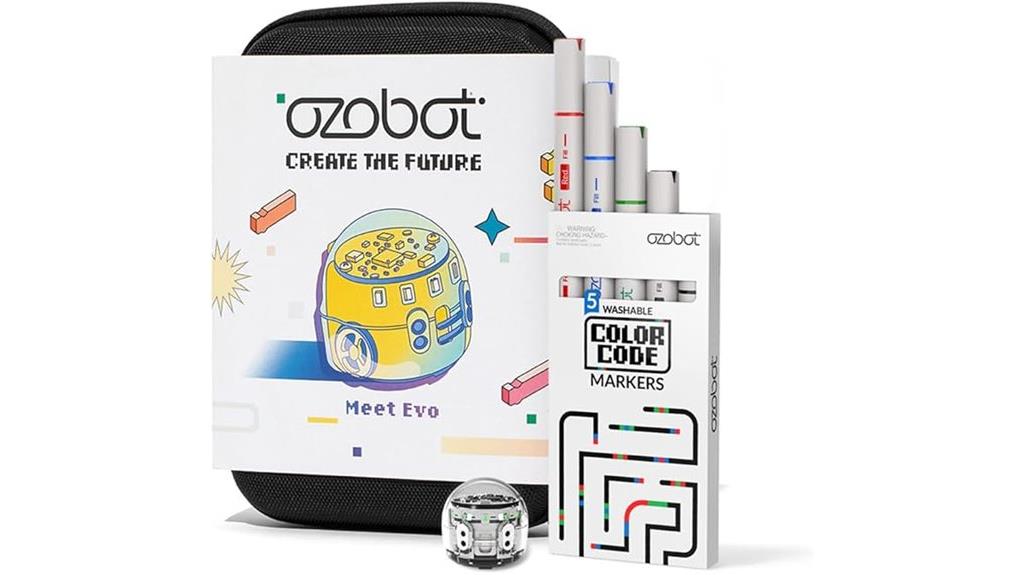
Looking for an engaging way to introduce young children to coding without relying on screens? The Evo Entry Kit Interactive Coding Robot is perfect for kids aged 5 and up. It includes a durable robot, markers, and access to over 700 STEM lessons, all designed for screen-free fun. Children draw color sequences to control Evo’s movements, helping them learn coding basics through hands-on play. It’s easy to set up, portable, and supports various skill levels with five stages of learning. Parents and teachers praise its durability and educational value, though some find the accessory assembly tricky. Overall, it’s a versatile tool that makes early coding both fun and accessible.
Best For: parents and educators seeking an engaging, screen-free introduction to coding for children aged 5 and up that promotes hands-on learning and foundational STEM skills.
Pros:
- Encourages creative, interactive play through drawing and puzzle-solving.
- Durable and portable design ideal for classroom or home use.
- Provides access to over 700 STEM lessons that grow with the child’s skill level.
Cons:
- Assembly of accessories like the crawler can be challenging.
- Sensitivity to lines and colors may affect performance.
- Some users find the coding features and app navigation less intuitive or limiting for advanced learners.
Makeblock mBot2 Coding Robot for Kids
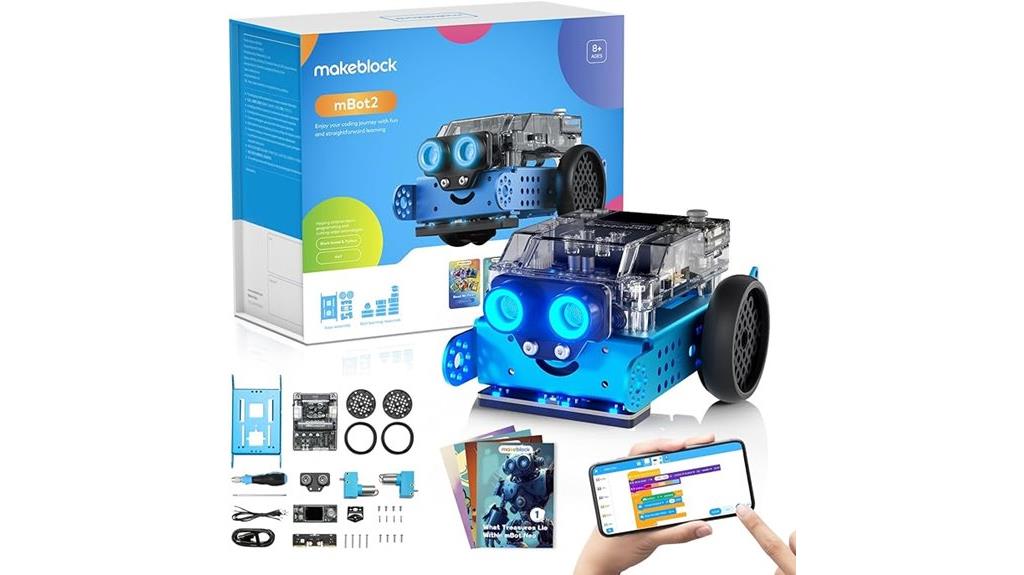
The Makeblock mBot2 Coding Robot stands out as an ideal choice for kids aged 8 to 12 who want to plunge into both coding and robotics with ease. It supports Scratch and Python, making it accessible for beginners and more advanced users. With over 10 sensors for tasks like obstacle avoidance and color detection, plus expandable modules for IoT projects, it offers versatility. The robot’s sturdy build, simple 30-minute assembly, and multiple control options via Bluetooth, Wi-Fi, or USB make it user-friendly. Its engaging features, like voice control and a programmable smart screen, inspire creativity and learning in both classroom and home environments.
Best For: young beginners and intermediate learners aged 8-12 who are interested in exploring coding, robotics, and IoT projects in an engaging and accessible way.
Pros:
- Supports both Scratch and Python programming for versatile learning.
- Over 10 sensors and expandable modules for diverse hands-on projects.
- Easy 30-minute assembly with multiple control options via Bluetooth, Wi-Fi, or USB.
Cons:
- Initial documentation may be limited, requiring additional online resources.
- Some advanced features might need extra hardware or upgrades.
- The robot’s complexity could be overwhelming for complete beginners without guidance.
Learning Resources Code & Go Robot Mouse (31 Pieces)
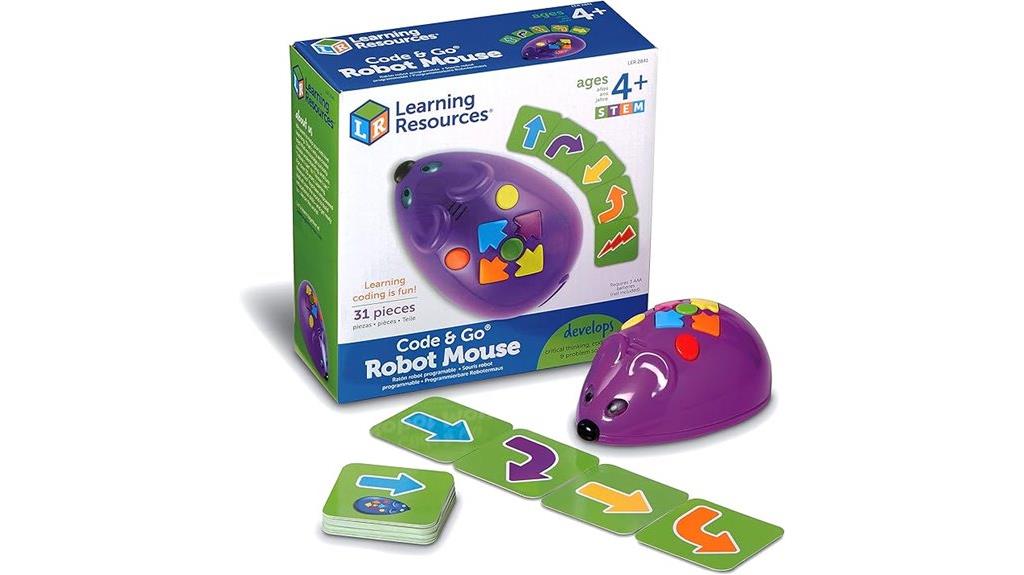
The Learning Resources Code & Go Robot Mouse stands out as a top choice for young children ages 4 and up who are just beginning their STEM journey. This 31-piece set offers a fun, screen-free way to introduce coding through colorful buttons and matching double-sided cards. The programmable mouse features lights, sounds, and two speed options, making it engaging and easy to control. With an included activity guide and compatibility with the expansion set, kids can explore maze navigation, problem-solving, and sequencing. Its durable, compact design makes it perfect for classroom, home, or gift use—encouraging critical thinking and creativity from an early age.
Best For: young children ages 4 and up who are beginning their STEM and coding education through hands-on, screen-free activities.
Pros:
- Encourages early STEM learning with interactive, programmable features.
- Durable, compact design suitable for classroom, home, or gifting.
- Easy to use with colorful buttons and matching coding cards, promoting problem-solving and critical thinking.
Cons:
- The turning radius may be limited due to the front ball bearing, affecting maneuverability.
- Requires 3 AAA batteries (not included), which may be an additional purchase.
- Some users may find the coding cards less versatile for advanced programming as skills develop.
Learning Resources Botley The Coding Robot 2.0 Activity Set

If you’re searching for a screen-free way to introduce young children to coding, the Learning Resources Botley 2.0 Activity Set is an excellent choice. This 78-piece kit offers a versatile, engaging experience that teaches core coding concepts like sequences, loops, and conditionals through multiple coding styles, including color coding and directional commands. With features like obstacle detection, object recognition, and transformation options, it keeps kids excited and challenged. Designed for ages 5 and up, it promotes STEM skills, critical thinking, and problem-solving while providing hours of fun. Its durable build and positive reviews make it a top pick for parents and educators.
Best For: young children aged 5 and up who are interested in screen-free, hands-on coding and STEM activities.
Pros:
- Teaches fundamental coding concepts like sequences, loops, and conditionals in an engaging way.
- Includes a versatile set of pieces for creative play, obstacle courses, and transformation challenges.
- Durable build and positive reviews from parents and educators highlight its educational value and quality.
Cons:
- Some units may experience sensor malfunctions or non-responsive movement requiring troubleshooting.
- Packaging and instructions may sometimes be lacking or not in the local language, causing initial setup difficulties.
- Minor issues with angles (90°, 45° turns) can lead to programming errors, necessitating careful planning.
Learning Resources Rechargeable Code & Go Robot Mouse for Kids
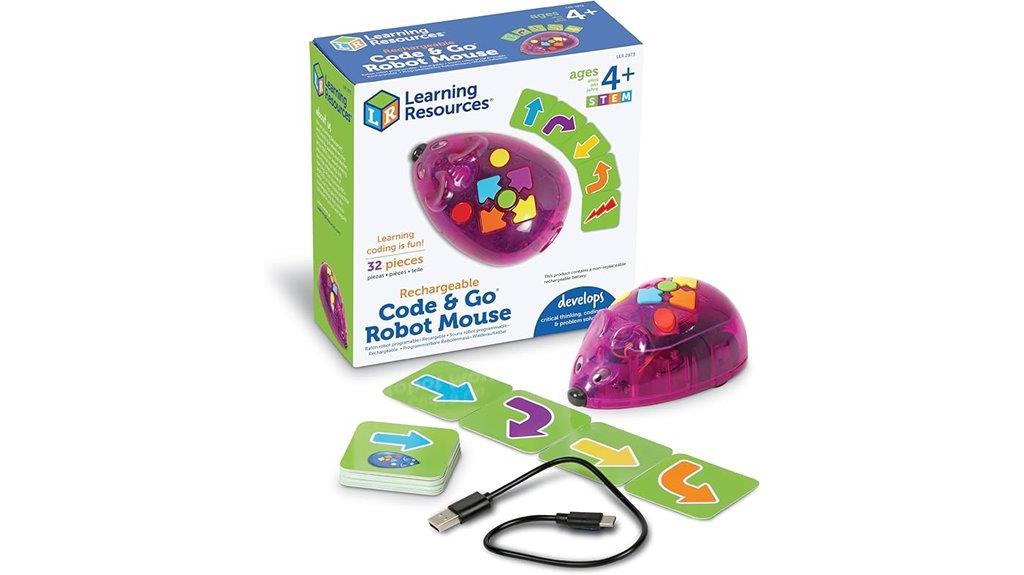
For parents and educators seeking a beginner-friendly coding robot, the Learning Resources Rechargeable Code & Go Robot Mouse stands out as an excellent choice. This interactive mouse introduces kids to coding through programmable buttons, colorful coding cards, and engaging sounds. Its rechargeable design means no batteries to replace, and its compact size makes it perfect for various environments. Kids can create paths, explore cause-and-effect, and develop problem-solving skills by programming the mouse to navigate mazes or obstacle courses. With simple controls and an activity guide, it’s accessible for children ages 4 and up, making learning to code both fun and practical.
Best For: young children and beginners interested in learning basic coding concepts in a fun, interactive, and educational way.
Pros:
- Engages kids with colorful buttons, sounds, and programmable features that make learning to code enjoyable.
- Rechargeable design eliminates the need for battery replacements, promoting sustainability and convenience.
- Supports creativity and problem-solving through maze and obstacle course creation, fostering STEM skills.
Cons:
- Limited turning capability (not turning a full 90 degrees) may restrict maze complexity.
- Some users have reported durability issues, such as the mouse spinning in circles after initial use.
- Price point (~$45) might be high for casual at-home use but is more justified in group or classroom settings.
Educational Insights PYXEL Coding Robot for Kids
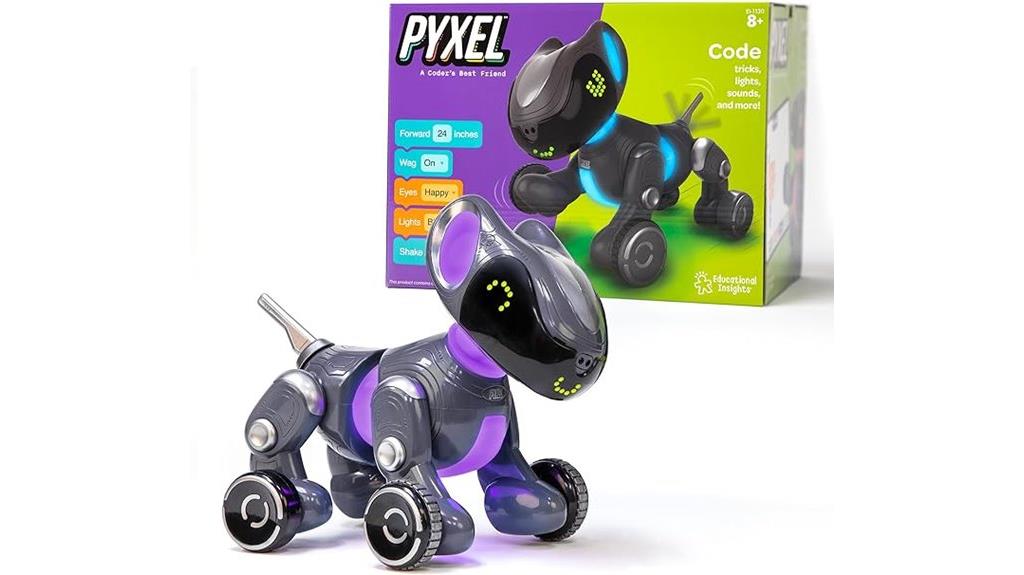
Educational Insights PYXEL Coding Robot stands out as an excellent choice for kids aged 8 to 14 who are just starting to explore coding or want a fun, interactive way to learn robotics. Its adorable robotic dog demonstrates tricks, expressions, colors, and sounds, making learning engaging. Supporting both Blockly and Python, it caters to beginners and more advanced coders. The device connects via Bluetooth or Wi-Fi without needing internet, ensuring secure, standalone use. Easy to set up and compatible with tablets or computers, PYXEL encourages hands-on learning, coding skills, and creativity. Despite some durability concerns, it remains a popular tool for fostering independent STEM exploration.
Best For: kids aged 8 to 14 who are beginners or intermediate learners eager to explore coding and robotics in a fun, engaging way.
Pros:
- Supports both Blockly and Python, catering to different skill levels
- Easy to set up and operate with a secure standalone connection via Bluetooth or Wi-Fi
- Promotes hands-on STEM learning through interactive tutorials, sounds, lights, and real-time actions
Cons:
- Durability issues such as LED lights failing within a month reported by some users
- Sound sensors may require loud noises to activate, limiting responsiveness in quieter environments
- Limited fun factor for some children over time, with potential decline in engagement
Learning Resources Switcheroo Coding Crew STEM Toy (46 Pieces, Ages 4+), Interactive Robot
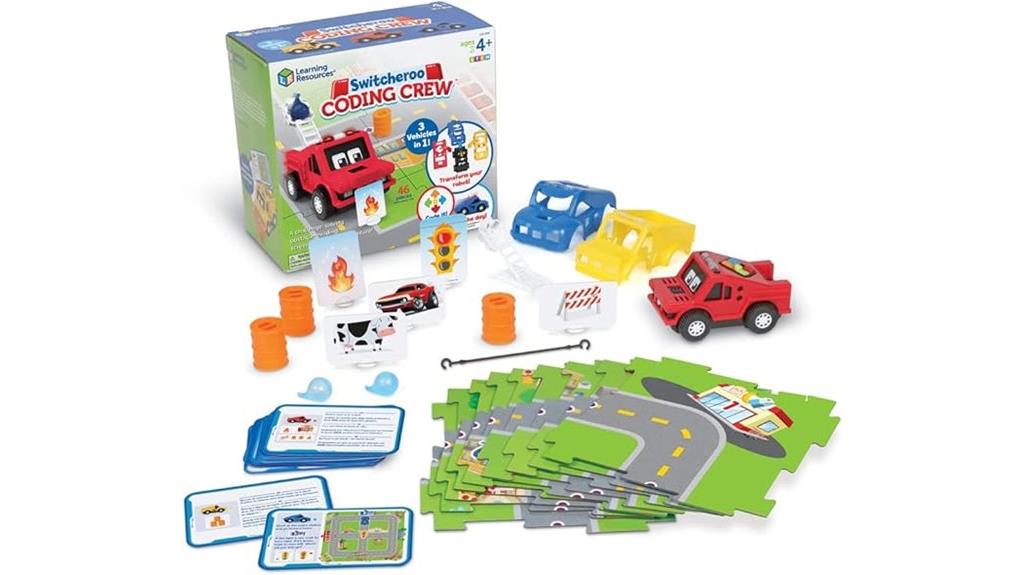
The Learning Resources Switcheroo Coding Crew STEM Toy stands out as an excellent choice for young children aged 4 and up who are just beginning to explore coding concepts. This 46-piece set features a three-in-one interactive robot that transforms into a police car, fire truck, or construction vehicle, offering screen-free coding challenges. Kids draw challenge cards, transform the robot, and program it to complete missions, fostering early STEM skills, critical thinking, and problem-solving. With simple programming modes and engaging sounds, lights, and tricks, it encourages active, creative play. Although some parts can be fragile, parents praise its educational value and ability to introduce coding in a fun, hands-on way.
Best For: young children aged 4 and up who are just beginning to explore coding concepts through fun, hands-on, screen-free activities.
Pros:
- Encourages early STEM learning, critical thinking, and problem-solving skills in a playful way.
- Transforms into multiple vehicle types, enhancing creativity and active engagement.
- Promotes teamwork and family involvement while introducing basic coding principles.
Cons:
- Some parts and components can be fragile or difficult to snap together, affecting durability.
- The instructions may be unclear or require multiple readings, which can slow down the learning process.
- The warped boards and fragile clips may limit gameplay or cause frustration for some users.
Learning Resources Code & Go Robot Mouse Activity Set
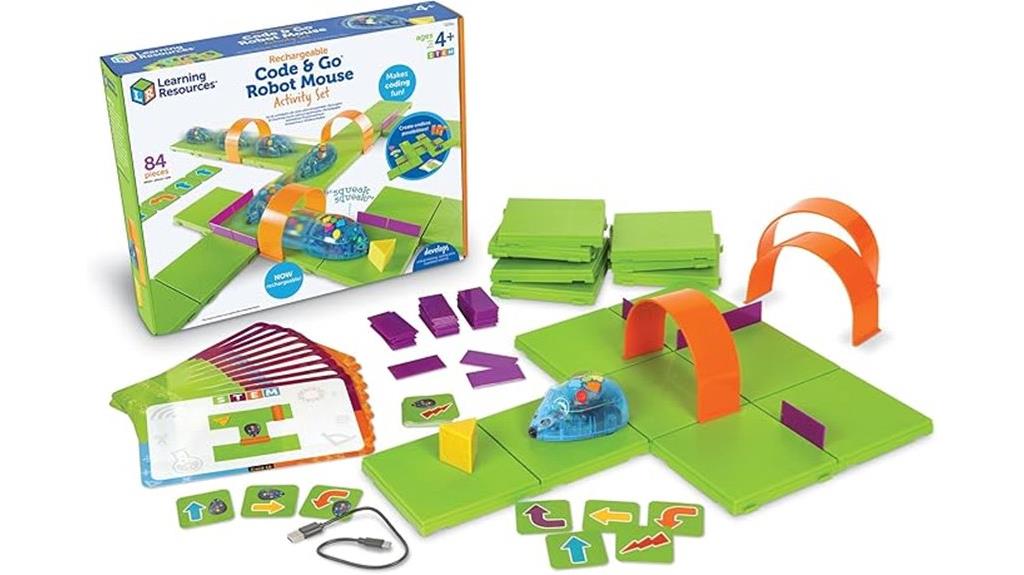
The Learning Resources Code & Go Robot Mouse Activity Set stands out as an excellent choice for young children aged 4 and up who are just beginning their coding journey. This screen-free, rechargeable toy combines fun with education, featuring a programmable mouse with lights, sounds, and simple controls. Kids can create mazes using maze grids, tunnels, and walls, then program the mouse with colorful buttons and coding cards. It promotes critical thinking, problem-solving, and foundational STEM skills in an engaging way. Durable and easy for little hands to manipulate, it’s perfect for home, classroom, or homeschool use, making early coding accessible and enjoyable.
Best For: young children aged 4 and up who are beginning to explore coding, STEM concepts, and problem-solving through a fun, hands-on, screen-free activity set.
Pros:
- Promotes early STEM skills, critical thinking, and problem-solving in an engaging way
- Durable, BPA-free components designed for young children’s easy manipulation and long-lasting use
- Fully rechargeable and battery-free, providing hours of screen-free play and convenience
Cons:
- Slightly pricey compared to other basic toys, which may be a consideration for some buyers
- Limited to early coding concepts; more advanced learners may find it too simple
- Requires adult supervision for younger children to fully maximize the educational potential
Factors to Consider When Choosing Coding Robots for Kids
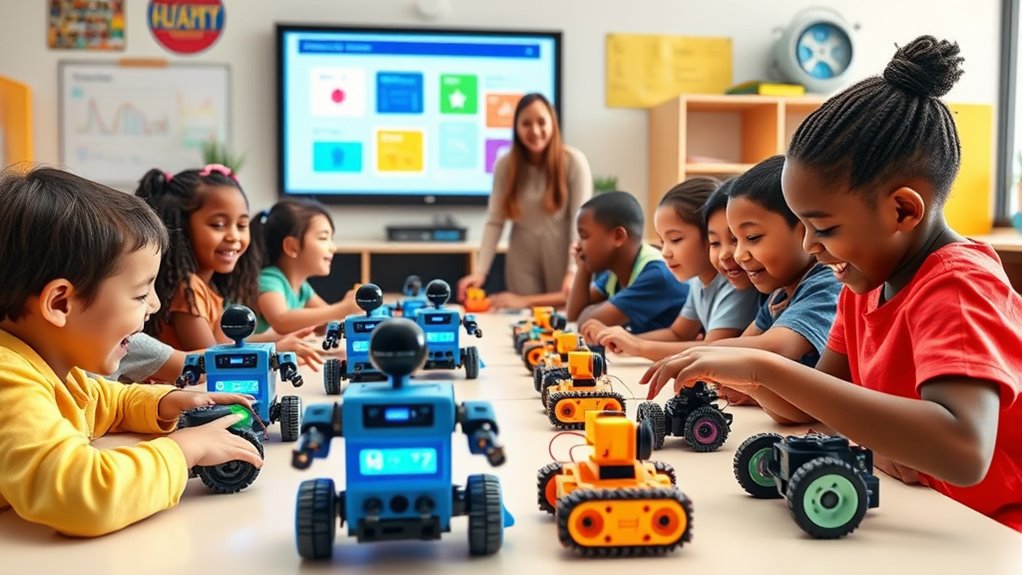
When choosing a coding robot for kids, I focus on several key factors to guarantee it’s a good fit. Things like age appropriateness, how easy it is to assemble, and the complexity of programming all matter. I also consider durability, educational value, and how well it supports learning and growth.
Age Appropriateness
Choosing the right coding robot depends heavily on your child’s age and developmental stage, as this guarantees they stay engaged without feeling overwhelmed. For younger kids aged 4-6, opt for robots with simple, screen-free interfaces and large, colorful controls that make learning intuitive and fun. As children grow to around 8 and older, look for options offering more advanced programming, like block coding or even text-based languages such as Python or JavaScript. It’s also important to contemplate the robot’s complexity, ensuring it matches their fine motor skills and patience for hands-on assembly. Additionally, features like obstacle detection, story-driven challenges, or programmable tricks should align with their cognitive and learning levels, keeping them motivated without frustration.
Ease of Assembly
Evaluating how easily a coding robot can be assembled is crucial because it influences your child’s initial experience and ongoing engagement. If the robot arrives pre-assembled, your child can start exploring right away, making learning more immediate. On the other hand, if extensive building is required, it might cause frustration or delay fun. Check whether the assembly involves small parts or tools, which could be tricky for younger kids or those with limited dexterity. Clear, step-by-step instructions, especially with visual guides or videos, are essential for smoother setup. Ideally, assembly should take less than 30 minutes, allowing your child to quickly shift from setup to play. A straightforward design encourages learning and keeps kids interested rather than discouraged by complicated assembly tasks.
Programming Complexity
Selecting a coding robot for kids involves considering how complex its programming features are, ensuring they match your child’s skill level. I recommend checking which programming languages the robot supports—block-based, JavaScript, or Python—so your child can grow comfortably. Evaluate whether the tasks start simple and progress to more advanced algorithms, encouraging continuous learning. Look for guided tutorials or challenges that introduce new concepts gradually, helping kids build confidence. Also, consider if the robot allows for open-ended programming, which fosters creativity and deeper understanding. User feedback on the interface is vital; it should be intuitive and age-appropriate to prevent frustration and keep kids engaged. Matching the programming complexity to your child’s abilities makes learning to code both fun and effective.
Durability and Materials
Durability and the materials used in a coding robot are essential factors that determine how well it can withstand active play. High-quality plastics like ABS or reinforced polycarbonate are common because they resist drops, collisions, and rough handling. These impact-resistant materials help extend the robot’s lifespan and keep it functioning after accidental falls. Robots with sealed components and sturdy outer shells are less vulnerable to damage from dust, spills, or internal moisture, ensuring long-term use. The choice of lightweight but durable materials also makes the robot easier for kids to handle without sacrificing resilience. Safety is equally important—look for BPA-free plastics and non-toxic finishes to ensure the robot is safe during energetic play. Overall, solid materials mean a more durable, long-lasting learning tool for children.
Educational Value
Have you ever wondered what makes a coding robot truly educational? It’s about more than just fun; it’s how well it teaches core programming concepts like sequencing, loops, and conditionals through engaging activities. The best devices also incorporate STEM skills such as problem-solving, critical thinking, and logical reasoning, which are crucial for overall development. Supporting multiple programming languages—block-based, text-based, or visual—allows for a smooth learning progression suited to a child’s age and skills. Additionally, extensive resources like tutorials and activity sets deepen understanding and keep kids motivated. A high-quality coding robot combines hands-on building, coding challenges, and real-world applications, fostering a long-term interest in STEM and helping kids develop essential skills while having fun.
Price and Budget
When choosing a coding robot for your child, considering the price and your budget can make a big difference in narrowing down the options. Coding robots vary widely, from affordable starter sets around $30 to advanced kits over $200. It’s important to think about long-term value—spending a bit more on a durable robot with extra features can offer more educational opportunities and last longer. Price often reflects features like programmable complexity, sensors, and compatibility with coding languages such as Scratch or Python. Also, look for bundle deals that include accessories and learning resources for better overall value. Be mindful of hidden costs, like batteries, replacement parts, or subscription apps, which can add up over time. Setting a clear budget helps you find the best fit for your child’s learning and your finances.
Compatibility and Connectivity
Is compatibility and connectivity really that important when choosing a coding robot for your child? Absolutely. You want to guarantee the robot works smoothly with your devices, whether that’s iOS, Android, Windows, or Chrome OS. Check if it supports Bluetooth, Wi-Fi, or USB connections—pick the method you find most convenient. Also, consider the robot’s connectivity range to keep it reliable during play or lessons, especially at home or in a classroom. If your child uses multiple devices, see if the robot can connect to more than one at a time for collaborative projects. Finally, verify that the app or software is regularly updated and compatible with current operating systems to avoid frustrating connectivity issues, ensuring a seamless learning experience.
Frequently Asked Questions
What Age Range Is Most Suitable for Each Coding Robot?
You’re wondering about the ideal age ranges for different coding robots. I find that most robots are designed for specific age groups to match developmental skills. For younger kids, around 5-8 years old, simple, block-based robots work best. Older kids, 9-12, can handle more advanced, programmable robots with coding languages. Always check the manufacturer’s recommendations to guarantee the robot suits your child’s age and skill level, making learning both fun and effective.
Do These Robots Support Programming in Multiple Languages?
Think of these robots as multilingual musicians, capable of playing in various coding languages. Most support popular options like Scratch, Python, or Java, allowing kids to switch tunes as they grow more confident. This flexibility turns coding into a universal language, making learning more engaging. So yes, many of these robots support programming in multiple languages, opening doors for young programmers to explore and expand their skills effortlessly.
Are There Available Accessories or Expansion Kits for These Robots?
You’re wondering if there are accessories or expansion kits for these robots. I can tell you, many of these robots offer a variety of add-ons and expansion kits that enhance their functionality. These include additional sensors, arms, or modules that help kids explore new projects and learn more advanced programming skills. It’s a great way to keep the learning experience fresh and engaging as children grow more confident with coding.
How Durable Are These Robots for Young Children?
Durability is a key factor when choosing a robot for young kids. I find that most of these robots are built with sturdy, child-friendly materials that can withstand rough play and minor accidents. While they’re designed to handle everyday use, I still recommend supervising younger children to prevent damage. Overall, these robots are quite durable and perfect for sparking curiosity without worrying too much about breakage.
Can These Robots Be Used for Classroom Group Activities?
Absolutely, these robots are great for classroom group activities! I’ve seen how they encourage collaboration and teamwork, making learning more engaging. They’re easy to set up, and kids love working together to code and solve problems. Plus, many come with shared coding platforms, so students can work on projects simultaneously. I believe they’re a fantastic way to foster creativity and communication in a classroom setting.
Conclusion
So there you have it—my top picks for turning your tiny human into a coding superhero, or at least someone who doesn’t crash their robot into walls. Whether you want a mini ball, a voice-activated buddy, or a kit that makes STEM feel like playtime, these robots prove learning to code can be fun (and maybe even a little addictive). Because who knew that debugging could be this adorable? Happy robot hunting!
